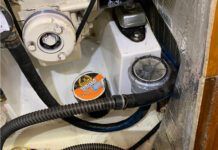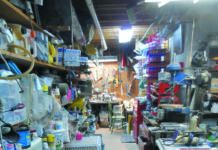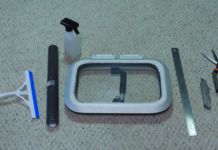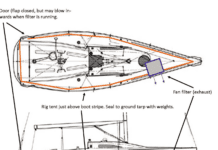Fuel-Fire Prevention Techniques
Marine firefighters estimate that you have less than 30 seconds to get a fire on any boat under control. Many items on your boat burn extremely hot, including fiberglass. It takes no time for liquids like gasoline, propane, or kerosene to reach flash point and give off combustible vapor. At that point, one spark causes combustion. (Diesel fuel has a relatively higher flashpoint, but it is still a flammable liquid that must be handled with care.)
On vessels, most serious fires start during fueling or cooking. Fuel fires almost always are the result of improper pre-fueling and post-fueling procedures. Galley fires combine improper preheating, storage, vapor ventilation, and failure to monitor cooking activities.
A basic checklist goes a long way in preventing common emergencies. Make it simple and keep it in a three-ring binder. Laminate the lists, or put them into document protectors, and separate the lists with tabbed inserts.
Below are the tools and steps required for safely fueling your boat.
1. Run blowers for 5 minutes to rid bilges of vapors. Close hatches, opening ports, vents (including dorados), and doors. On sailboats, insert dropboards into the companionway opening and close sliding hatch.
2. Keep a fire extinguisher ready for immediate use. Remove one of the portable extinguishers from its bracket. Lay it on deck, on its side, to keep it from rolling around.
3. Place diapers or absorbent pads over downhill scuppers and drains. This prevents fuel form spilling from the deck and into the cockpit and overboard.
4. Assign one crewmember to watch the fuel gauge. V-shaped fuel tanks cause gauge readings to be somewhat erratic. The gauge rises quickly when you start fueling, and then slows to a crawl near the tank top.
5. Place a rag around the nozzle or fuel fill hole. Insert the nozzle and maintain contact with the fill to prevent buildup of static electricity. When you are three-quarters full, assign a crewmember to monitor the fuel vent. Have him or her hold an absorbent pad or diaper under the vent in case of overflow. Top off each tank to 90% to allow for expansion.
6. Replace the nozzle and wipe up any spills. Check the cap gasket for cracks and proper seating. A cracked or worn gasket leads to water intrusion into the fuel tank. Replace and tighten down the fill cap. Check all around the boats waterline for fuel spills. Cleanup any spill immediately with absorb pads. Do not – under any circumstances – use a dispersant. (This is a U.S. federal law.)
7. Open all vents, hatches, opening ports, and doors. Run the blowers for 5 minutes. Tour the vessel and snip for vapor fumes. If you smell fuel, locate the source before you start the engine. After starting the engine, check the waterline again for spills – paying particular attention to the area beneath each fuel vent. Check the engine compartment for fuel leaks.
For 185 tips and techniques that you wont find in any textbook, but will work quickly and reliably every time, buy Seamanship Secrets, 185 Tips & Techniques for Better Navigation, Cruise Planning, and Boat Handling Under Power or Sail from Practical Sailor.






































